Pipe
Spring National Monument
The
water of Pipe Spring has made it possible for plants, animals, the ancestral
Puebloans and the Kaibab Paiute Indians to live in this dry desert region. The Indians gathered seeds, hunted animals
and raised crops near the Pipe Spring for at least 1,000 years.
By
the late 1850’s missionary expeditions to the Hopi mesas by the Church of the Latter-day
Saints also found this Spring. Mormon pioneers
began to move into the area causing considerable challenges for the native
Indians already living around the Spring.
In the mid 1860’s the Apache, Navajo and Paiute tribes joined with the
Utes for the Black Hawk War and the Tribes raided the Pipe Spring. It was after this attack that the fort was
constructed over the main spring, cutting the water availability for the
Indians off. Anson Windsor was hired by
the Church of Latter-day Saints to operate the now thriving cattle ranch and
maintain the fort, which was soon called Windsor Castle.
The fort was built in a square which surrounded an open court in the middle. There were very large heavy doors on each end of the
courtyard. It is a two story building with several rooms.
The outside walls had these 'gun windows' reminding everyone why the fort was built.



The ground floor was a few steps below ground level and very cool. This is where the work was done like making cheese. This photo shows how creative the people were in the way they made this 'cooling/storage' rack. This room was also cool enough for salted meat storage.
If you look at the bottom of this photo you will see a box that is open a few inched on the top. This is where the Pipe Spring was built into the fort prohibiting the established Indian
Tribes access to the water. The pool that you see in the beginning photo is where the Pipe Spring drains out, and it holds the occasional rain water. The pool is used to irrigate the fruit trees, grapes and other gardens.
It
served as a way station and as a refuge for polygamist wives during the 1880’
and 1890’s. There were many families
that maintained the fort over the years from the Church of the Latter-day Saints
and private owners after the Church lost ownership of the ranch. The pioneers proved detrimental to the Kaibab
Band of Paiute Indians due to the loss of access to the Spring. Although the American Indians struggled after
the loss of water access with their traditional subsistence lifestyle they
chose to stay. The Kaibab saw a drastic
decline in population, worked through government assimilation programs such as
Indian boarding schools and the termination of reservations. By 1907 the Kaibab Paiute Indian Reservation
was reestablished surrounding the now privately own Pipe Spring ranch. The Church of the Latter-day Saints lost
ownership of the property through penalties involved in the passing of the
federal Edmunds-Tucker Act of 1887.

Today
the Spring is protected and operated by the National Park Service as a National
Monument. Here are a few more photos of
the Pipe Spring today. Enjoy!
More
to come soon 😊
Jan 🌷🌷🐾🐾 


































No comments:
Post a Comment